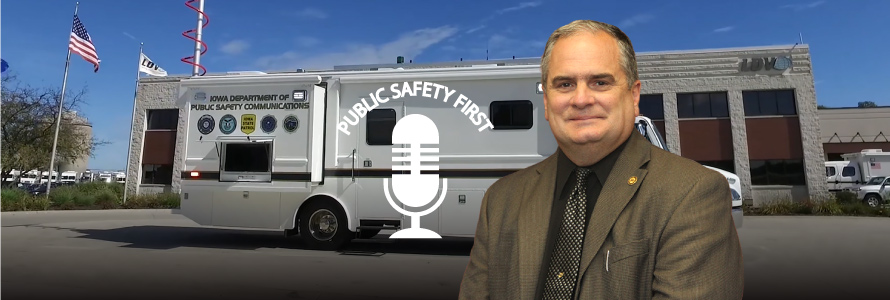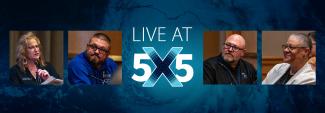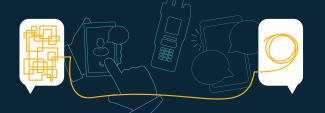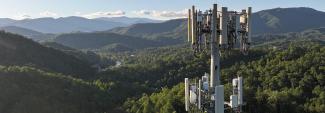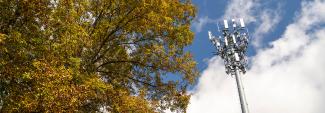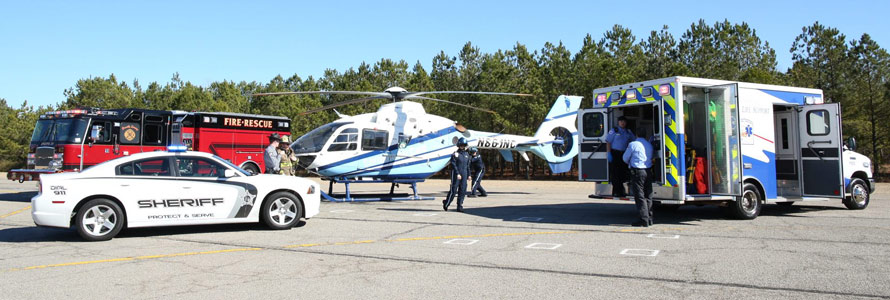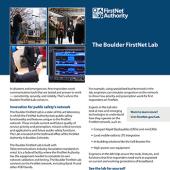Summary
The Iowa Statewide Interoperable Communications System (ISICS) Board, led by Board Chair Tom Lampe, was formed in 2007 to create and manage the statewide land mobile radio system known as ISICS. Coupled with the buildout of FirstNet, ISICS has given first responders across Iowa’s 99 counties access to reliable, redundant communications. The LMR and LTE systems have played critical roles in day-to-day response as well as major incidents, including the 2020 derecho storms and a recent missing children’s case.
Guest
David Buchanan
FirstNet Authority Executive Director of Public Safety Advocacy
Tom Lampe
Board Chair, Iowa Statewide Interoperable Communications System
Transcript
Preview
Narrator: You're listening to Public Safety First, a podcast to help you learn about the First Responder Network Authority and how you can be part of the future of public safety technology.
And now, your host.
Dave Buchanan: Welcome to the Public Safety First Podcast. I’m Dave Buchanan, Executive Director of the Public Safety Advocacy Team at the First Responder Network Authority. I’m joined today by Tom Lampe, chair of the Iowa Statewide Interoperable Communications System Board [ISICSB]. Thank you for joining us today, Tom. Welcome to the podcast.
Tom Lampe: Well, it’s great to be here. I appreciate you asking.
Dave Buchanan: So, let’s start by talking a bit more about the ISICSB. What does your group do and how is it impacting public safety communications in Iowa?
Narrator: You're listening to Public Safety First, a podcast to help you learn about the First Responder Network Authority and how you can be part of the future of public safety technology.
And now, your host.
Dave Buchanan: Welcome to the Public Safety First Podcast. I’m Dave Buchanan, Executive Director of the Public Safety Advocacy Team at the First Responder Network Authority. I’m joined today by Tom Lampe, chair of the Iowa Statewide Interoperable Communications System Board [ISICSB]. Thank you for joining us today, Tom. Welcome to the podcast.
Tom Lampe: Well, it’s great to be here. I appreciate you asking.
Dave Buchanan: So, let’s start by talking a bit more about the ISICSB. What does your group do and how is it impacting public safety communications in Iowa?
Tom Lampe: So, in 2004, this became a governor’s taskforce recommendation to address the interoperability in Iowa after 9/11 to ensure that Iowa had the proper interoperability communications system in place. So, they formed a taskforce back then, and they recommended that an interoperability board, a governing board be formed. So, in 2007, the board was officially formed with sixteen members at the time. It has now grown to 19 members today. They represented two from each entity. So, you have, two from police, two from fire, two from EMS, members at large, covering all the entities in public safety that would deal with interoperability. So, as the board got formed and in place, they also added four legislative liaisons from the legislature in case there needed to be funding requests, laws formed based off board decisions, so it was important that we had our senators and our representatives involved at the board level, non-voting but just membership of the board. That was important.
So, now that we’ve got the baseline for the board, their task and their ultimate objective back then was to create an interoperability network in the state of Iowa. So, they contracted with a firm to do a study in Iowa of what it would take for an interoperability system. They recommended a statewide radio system to provide statewide coverage in each county, in all 99 counties as it is today, for a 95% coverage in each county. That did not mature for a lot of reasons because the state budget at the time and other factors. So, it kind of stayed idle for a few years.
So, I was put on the board, with a specific task to get this moving forward to come to completion. So, I recommended to place an RFI, a Request for Information, to have the vendors look at the Master Plan for Iowa and decide what they could provide Iowa, as far as a radio system. So, I took a different approach on this and we placed an RFI asking for the 95% mobile coverage across the entire state, not just at each county. To make a long story short, Motorola won the bid. That’s how the ISICS system, which is in place today, kind of took place and how it was evolved.
At the same time, FirstNet was maturing in the background. I was involved in that as well. So, we were going through state consultation. The broadband committee was formed for the board, in which we were going to opt in or opt out. We ended up being fifth to sign in. So, that’s kind of the history of where we, very reader’s digest condensed version, of how the board was formed to where the ISICS was the main function of the board.
Dave Buchanan: So, you worked from 2007 through 2015 to really take on a lot of different responsibilities. You had to come up with a governance program, you had to pull together diverse set of interests at the state and local level to come up with your governance body, you had to think about coverage and the technology aspect of this, you had to identify a private sector partner. So, a lot of the similar things we were dealing with at FirstNet later on, you were already tackling in Iowa with ISICS, so I think that’s a great story, Tom.
So, you and I got to meet each other in 2013 when we started the consultation process. Can you share a little bit with our listeners the steps you took to get public safety input across those 99 counties? Because I thought that was impressive – the outreach you made and the emphasis you put on making sure you heard from firefighters, law enforcement officers, paramedics, and others in all the corners of Iowa. Can you talk about that for a little bit?
Tom Lampe: Yes. So, at the same time the FirstNet initiative was brought also came along the SLIGP [State and Local Implementation Grant Program] grant. So, the grant was available to the states. So, we took that grant and used it as an aggressive, very aggressive, outreach program. So, my goal was to touch every single entity and every county of the state, which is 99 counties. We hired an outreach specialist and he was charged with going to each county. And he took 14 months to get it completed, but they needed to be touched with the vision of what is coming for FirstNet in Iowa, what it would do for public safety first responders. So, when we finished the 99 counties, we then went to the regional approach. So, I watched the FirstNet clock and how the FirstNet was developing, and then I put out a regional interoperability plan using SLIGP funds. So, at that point, I broke up the six homeland security regions in the state, I broke and formed what we call today, what still are in existence are called Regional Interoperability Committees – RICs, we call them. Each region has a chair and a vice chair and members of each RIC. The intent was, so when FirstNet was developed as it is today, those members of each RIC in their region would have say on how the network was coming in their areas, the buildout. And it’s worked out very well, because now the RICs intertwine with the FirstNet broadband subcommittee. You know, when FirstNet’s building in different sections of Iowa, they report on how their service has been. And then that opened up doors for communication between AT&T and the FirstNet Authority. So, it all worked out very nicely.
Dave Buchanan: So, you guys clearly identified very early on how important it was to get input at the local level and the state level, how important it was to get feedback, how important it was to get buy-in and support. And I really believe that your governance model and outreach model is a best practice for how state leadership can help improve public safety communications. So, I really appreciate what you’ve done, Tom, and what your team has done since 2013.
I want to talk now a little bit more about these systems and how they complement each other. You’re obviously responsible for the LMR system in Iowa. Those of us at the First Responder Network Authority responsible for the Nationwide Public Safety Broadband Network, FirstNet. And we know and have heard firsthand from public safety how important it is that they have strong networks in both the LMR and LTE sides. And when first responders are strained and operations are strained, having networks they can rely on that are complementary of each other are really important. We also know and have heard how challenging storms can be to that redundancy and how storms and natural disasters can compromise networks.
And we know that during the most recent derecho that you experienced in Iowa that networks across the board experienced some degradation and were compromised. One of the things we have at FirstNet to help first responders have a good handle on the status of the network is the Network Status Tool. It’s a really unique, one-of-a-kind service for FirstNet users. It’s a map that really shows at the street level performance of the network – where there’s outages, if there are any, where there’s service, if there is any. And we’ve heard time and time again how much confidence that gives the FirstNet user, to be able to use that map and use that dashboard to give them, again, really one of a kind, in the LTE world, status of the network and the network performance.
So, with all that, Tom, I wanted to turn it to you, and have you share with us some of your observations from the derecho storm. How did public safety utilize your system, and how did the communications go for first responders during that time of emergency?
Tom Lampe: So, about ten minutes to 11 on a Tuesday, here comes the storm. And I’m personally sitting in Des Moines, watching my system. And I was watching this this storm come go across town and I’m watching the LMR network – because we have a microwave network. And that means we have no hard line in the ground that serves our sites, it’s all microwave. And microwaves are built to withstand a certain amount, but there are also, there is limits to everything. And, in two regards, the size of the dish, there’s redundancy on everything, and rain fade – all that comes into effect. So, I’m watching it and everything’s staying green. But then all of a sudden, I’m getting reports that we’re losing service on the cellular side. Not only just with the AT&T network, but the other networks, as well. We’re getting those calls that, “Hey, we don’t have any cell service.”
So, the storm went through and the next day, I was real concerned with amount of wind that was coming through and the velocity of it. I was really concerned about the antennas on top of the tower and how much wind were they going to be able to withstand. So, my main concern, knowing that I’m looking at my system here, and I’ve had, I had a few blurps on the screen. And I know what the blurps mean. The blurps mean that the microwave signal was off, and I assumed the dishes were out of align. But they were hanging on the best they can. I would get signals and then they would lose it. So, in the meantime, I got it across the back of my mind that I’ve got to get out there, and I’ve got to look at these sites to see what’s going on. So, I went out, and started east on I-80, and my cell service was hit and miss. Then I had to revert to my LMR system to use the voice portion on that for, what we call private call. So, it’d be radio to radio. So, I was using that feature on the radio network when I didn’t have service on the AT&T FirstNet network. So, I went around, did my thing – and where I’m going with this is, the one backed up the other. The one survived, and the one took a little bigger hit than the other. But they both survived. FirstNet came through with AT&T was calling me and wanted to know where I wanted the deployables. And I said, “Well, you could probably take one and put it from Marshalltown in the center of the state. You can keep putting them on I-80 all the way to Cedar Rapids.” So, what I’m getting at is, I had a redundancy as I traveled east. Personally experienced how redundancy and how important it is for the LMR piece and how it complements the broadband and how broadband complements the LMR piece in that situation of, as far as a derecho.
Dave Buchanan: So, let’s talk about another example about how the ISICS system and FirstNet are providing complementary redundancies for first responders in Iowa. Can you tell our listeners about the mobile command vehicle integration project your team is working on?
Tom Lampe: Yes. So, we have a brand-new mobile command that we just purchased last fall. And my goal was to have it as a dispatch center and also as a supplemental coverage mechanism for if we were in an area where there was not enough portable coverage for first responders for that incident, to be able to have that vehicle fill in the hole of the ISICS system. Normally when you have a mobile command and you have radios to pass out, you have a cache of radios in a vehicle that are tuned to that site, and what that’s called is basically site trunking. So, you have to have a talk group that’s tuned to that site only, because that site can’t talk to the core because you don’t have the connection back to Des Moines, so to speak, where the core resides. You have to do that in such a way as use satellite or you have to use, if you have, if you’re fortunate enough to have an ethernet connection to have a comms center or something you could maybe get to the core, but it still takes a lot of configuration to get that done. It’s more beneficial to me to have a mobile command center with an antenna in the air that talks to the core. So, the core recognizes that mobile command when we turn it on. It’s just another site a radio can roam to.
So, Motorola had been working, and they have several examples in the United States where they’re using satellite to do this. Well, satellite has latency, and it depends on a lot of the weather, knocks that stuff down. So, I challenged them to use the FirstNet network to get back to the core. Not just to an LTE network on a cellular network, I wanted the FirstNet network, because I know what there was going to be eventually, is priority, preemption, and we build based on geography not population. So, I said, “I need an LTE connection from the mobile command to the core.” And just, not to go into the details, but today we have the mobile command that has an LTE FirstNet connection wirelessly to the core as if it was in a dispatch center. So, not only does it fill in the hole of the ISICS system through the LTE getting to the core, we can also now dispatch as if we’re sitting in a comms center, talking to the core. So, that LTE connection is now established anywhere in the state of Iowa to talk to the core. And so, when your radio is on, I don’t have to hand you out 50 radios tuned to that site. Anybody that shows up to the scene that has the ISICS interoperability system – which is all public safety – radio roams to the site as if it’s just another day.
I’m also going to use FirstNet for 9-1-1 in that mobile command. So, what that means is we will have a router with FirstNet, and it will have software with laptops, so, now we will be able to take a 9-1-1 call in the geographical area that that mobile command will be serving, using FirstNet LTE across the air to get 9-1-1 calls to that vehicle. So, we kind of broke through two molds. We got, now we have a wide area trunking site through LTE back to the core, and we have a complete 9-1-1 comms center that is able to take 9-1-1 calls within the geographical range of where we’re at, and easily set up within minutes.
Dave Buchanan: Tom, what’s an example that you would share with others about how this is going to improve public safety operations in Iowa?
Tom Lampe: So, we’ve already used it twice. The first use was we had an Amber Alert, with a missing child over in Clinton, Iowa, eastern part of the state. They had a search area. So, they deployed it over there, put the antenna in the air, and they used the dispatch piece of the mobile command with their radios in and around. And we also used their own radios, which we didn’t have to hand out any radios, because they had their own, for their coverage in that area they were searching.
The second instance we just got back the other day was the city of Clinton, the same area, lost their VHF tower that provided coverage to their downtown area of Clinton on the VHF side. So, I deployed the mobile command, and that provided their on-street coverage on the ISICS system. They ended up getting some radios from Motorola. And then what I did was I took that technology that I used for the mobile command and I incorporated that same concept using FirstNet LTE in our mobile trailer that the board owns, which has the same technology in it. So, now today, that trailer, with the antenna in the air and LTE FirstNet, is connected to the core providing the city of Clinton with all the coverage they need in downtown until they get their system back up.
Dave Buchanan: That’s terrific. Tom, you’ve obviously been in law enforcement in Iowa for a long time. What does FirstNet bring to the law enforcement community that you didn’t have before?
Tom Lampe: FirstNet brings the broadband side of preemption, priority, and the reliability, and the fact that it’s their network to their mobile world for public safety – fire, EMS, police – complementing the LMR piece. So, you have data that’s streamed to you on buildings, on floorplans, camera activation, live camera feeds before you get to the scene, as you’re en route to the scene, sending your reports back and forth, photos from the scene getting piped in. You need a reliable network, especially during an emergency, so that data gets through, and not having to compete with the commercial side. That’s what FirstNet brings to public safety is that priority, preemption, and guarantee that if you’re driving down the interstate, so to speak, and all the lanes are plugged, you can drive right on by, because you have your own lane to get past.
Flooding, tornadoes, we’ve had those where FirstNet was priority. We got through, but nobody else did and it worked.
Dave Buchanan: Really glad to hear your observations about public safety operations during the derecho. And I love the example of your mobile command vehicle.
So, we’ve gotten word that you’re going to be announcing your retirement soon. I understand you’ve been with Iowa State Police for more than 30 years. When you look back on your career what work are you most proud of?
Tom Lampe: I started when I was 19 years old. Law enforcement related, I’ve been in it well over 35 years. But I’ve also been involved on the EMS side. I was an ambulance volunteer for that piece. I’ve been with the fire. So, throughout, the piece that I loved the most was, this last eight years is who had ever thought that a state trooper in the Iowa State Patrol would be responsible ultimately where we’re at today, is responsible for a radio network, two of them at the same time, basically, being the State Point of Contact [SPOC], and that’s been my most glorious time for me was, you know, coming up through the ranks and being able to stand in front of a crowd and say I’ve done what you’ve done. And so, I know what you’re saying. I know what I can get you for the equipment. I know what you need for your job. And to see when I walk into an AT&T store to see that FirstNet logo and see the plans that are available. Knowing that I was there before the logo was even built. I was there before the board was formed. I was there on the very first SPOC meeting. That’s what gives me the greatest pleasure. And then, knowing that when I leave, when I drive by, that the public safety that I see alongside the road is using the FirstNet network and the radio network that I helped build for their push-to-talk LMR is serving them. And I can walk out the door knowing that that has been successful. But now it’s time to move on to the next chapter, but to keep assisting public safety with the knowledge that I have. Because I do have a lot to share through all those years. And it’s very important to me that I be able to share that with people in years to come.
Dave Buchanan: Tom, on behalf of the First Responder Network Authority I want to congratulate on your retirement. I want to congratulate you on your 35-year career in law enforcement. I personally want to thank you for your friendship, and you being one of our key champions out in the state. As I said, you and I have been working together to help bring FirstNet to life since 2013, and I appreciate what you’ve been able to do for public safety and what you’ve done for the network. So, thank you for that. And thanks for joining this podcast. Glad to have this conversation with you. And I’m glad our listeners are going to get to learn from you on the opportunities and challenges of public safety communications in your state. So, thank you very much.
Tom Lampe: I really appreciate it.
Narrator: Thanks for listening today. We're excited to have you join our podcast community. Make sure to subscribe on iTunes, SoundCloud, and YouTube. You can learn more about the First Responder Network Authority at FirstNet.gov and learn about FirstNet products and services at FirstNet.com.


